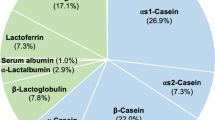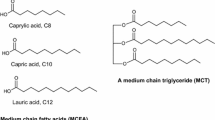Abstract
In rhesus monkeys, maternal n-3 fatty acid deficiency during pregnancy produces infant monkeys deficient in n-3 fatty acids at birth. These results stimulated current experiments to find out if n-3 fatty acids from fish in the diets of pregnant women would influence the concentration of docosahexaenoic acid (DHA, 22:6 n-3) in the newborn human infant.
Fifteen healthy pregnant women were enrolled to receive a 9-wk dietary supplementation of n-3 fatty acids from the 26th to the 35th wk of pregnancy. Sixteen pregnant women were not supplemented and served as controls. n-3 Fatty acid supplementation consisted of sardines and additional fish oil, which provided a total of 2.6 g of n-3 fatty acids per day (d) for the 9-wk period of supplementation. This included 1.01 g DHA.
The end point of this study was the blood concentrations of DHA in the newborn infant. DHA in maternal red blood cells increased from 4.69% of total fatty acids to 7.15% at the end of the supplement period and at the time of delivery decreased (as expected) to 5.97% of total fatty acids. Maternal plasma showed a similar change from 2.12 to 3.51% of total fatty acids and then decreased to 2.35%. Levels of DHA in plasma and red blood cells of unsupplemented mothers did not change during the same time period.
Levels of DHA in blood of newborn infants differed greatly in infants born from n-3-supplemented mothers compared with control infants. In red blood cells, DHA was 7.92% of total fatty acids compared with 5.86% (control infants). Plasma values showed a similar difference: 5.05% vs. 3.47% (controls). In n-3-supplemented infants, DHA concentrations were 35.2% higher than in control infants in red blood cells and 45.5% higher in plasma.
These data indicate the importance of maternal dietary n-3 fatty acids and, in particular, maternal dietary DHA in promoting higher concentrations of DHA in the blood of the newborn infant.
Similar content being viewed by others
Abbreviations
- DHA:
-
docosahexaenoic acid
- EPA:
-
eicosapentaenoic acid
References
Connor, W.E., and Neuringer, M., (1987) Importance of Dietary Omega-3 Fatty Acids in Retinal Function and Brain Chemistry, inNutritonal Modulation of Neural Function, Morley, J.E., Walsh, J.H., and Sterman, M.B., ed., UCLA Forum in Medical Sciences, Number 28, Academic Press, New York, NY, pp. 191–201.
Ruyle, M., Connor, W.E., Anderson, G.J., and Lowensohn, R.I., (1990) Placental Transfer of Essential Fatty Acids in Humans: Venous-Arterial Differences for Docosahexaenoic Acid in Fetal Umbilical Erythrocytes,Proc. Natl. Acad. Sci. USA 87, 7902–7906.
Anderson, G.J., and Connor, W.E., (1988) Uptake of Fatty Acids by the Developing RAt Brain,Lipids 23, 286–290.
Clandinin, M.T., Chappell, J.E., Heim, T., Swyer, P.R. and Chance, G.W. (1981) Fatty Acid Utilization in Perinatal de novo Synthesis of Tissues,Early Human Dev, 5, 355–366.
Connor, W.E., Lin, D.S., Neuringer, M., Reisbick, S., and Anderson, G.J. (1993) The Comparative Importance of Prenatal and Postnatal n-3 Fatty Acid Deficiency: Repletion at Birth and Later, inProceedings of the Third International Congress on Essential Fatty Acids and Eicosanoids, Sinclair, A.J., and Gibson, R.A., eds., American Oil Chemists’, Society, Champaign, IL, pp. 156–160.
Neuringer, M., Connor, W.E., Lin, D.S., Barstad, L., and Luck, S. (1986) Biochemical and Functional Effects of Prenatal and Postnatal Omega-3 Fatty Acid Deficiency on Retina and Brain in Rhesus Monkeys,Proc. Natl. Acad. Sci. USA 83, 4021–4025.
Uauy, R.D., Birch, D.G., Birch, E.E., Tyson, J.E., Hoffman, D.R. (1990) Effect of Dietary Omega-3 Fatty Acids on Retinal Function of Very-Low-Birth-Weight Neonates,Pediatr. Res. 28, 485–92.
Carlson, S.E., Wexman, S.H., Rhodes, P.G., and Tolley, E.A., (1993) Visual-Acuity Development in Healthy Preterm Infants: Effect of Marine-Oil Supplementation,Am. J. Clin. Nutr. 58, 35–42.
Editorial (1992) Fish Oils in Pregnancy,Lancet 339, 1327–1328.
Olsen, S.F., Hansen, H.S., Sorenson, T.I.A., Jensen, B., Secher, N.J., Sommer, S., and Knudsen, L.B. (1986) Intake of Marine Fat, Rich in (n-3) Polyunsaturated Fatty Acids, May Increase Brith Weight by Prolonging Gestation,Lancet ii, 367–369.
Olsen, S.F., Hansen, H.S., Sommer, S., Jensen, B., Sorensen, T.I.A., Secher, N.J., and Zacgarusasseb, P. (1991) Gestational Age in Relation to Marine n-3 Fatty Acids in Maternal Erythrocytes: A Study of Women in the Faroe Islands and Denmark,Am. J. Obstet. Gynecol. 164, 1203–1209.
Olsen, S.F., Sorenson, J.D., Secher, N.J., Hedegaard, M., Henriksen, T.B., Hansen, H.S., and Grant, A. (1992) Randomized Controlled Trial of Effect of Fish-Oil Supplementation of Pregnancy Duration,Lancet 339, 1003–1007.
Olsen, S.F., and Secher, N.J. (1990) A Possible Preventative Effect of Low-Dose Fish Oil on Early Delivery and Pre-Eclampsia: Indications from a 50-year-old Controlled Trial,Br. J. Nutr. 64, 599–609.
Author information
Authors and Affiliations
About this article
Cite this article
Connor, W.E., Lowensohn, R. & Hatcher, L. Increased docosahexaenoic acid levels in human newborn infants by administration of sardines and fish oil during pregnancy. Lipids 31, S183–S187 (1996). https://doi.org/10.1007/BF02637073
Issue Date:
DOI: https://doi.org/10.1007/BF02637073




